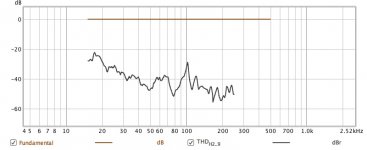Hello how much should be a good THD% (@1W @1Khz) and a good IMD% (@60Hz+7KHz summed together in a 4:1 amplitude ratio) for a loudspeaker measured in ambient (home room)?
I got (at two meters) 0.11% THD@1KHz (which I think is good) but 2.8% IMD (@60Hz+7KHz) which doesn't convince me.
Thanks
I got (at two meters) 0.11% THD@1KHz (which I think is good) but 2.8% IMD (@60Hz+7KHz) which doesn't convince me.
Thanks
Last edited:
THD or IMD without SPL levels don't tell you what is "good".
Amplifier output was 2.83V. (thus about 1W @ 8 ohm)
Loudspeakers (two ways) were at 2 meters from mic (in axes to the mid point tweeter-woofer)
SPL@1m is 89dB by datasheet and simulations, hence at 2meters should be 83dB (6 db less).
Hello how much should be a good THD% (@1W @1Khz) and a good IMD%...
I have no intuition about IMD in speakers.
But my impression is that for ordinary listening levels, THD below 1% is pretty acceptable for mid and treble speakers playing music. (My electrostatic panels run about -45dB, which includes fire trucks in the distance, etc.)
For woofers playing music, "acceptable" is pretty hard to nail down because bass music is full of harmonics and so distortion is less of an annoyance. Below 40 Hz, a woofer can rise above 10% and be considered OK.
Here's my 1956 AR-1, tested at ordinary listening levels.
BTW, tricky to do these measurements. As levels go up to a point, the measurements start looking better because the noise and background sound diminish in impact. But when getting loud, distortion rises, as you'd expect.
BTW, tricky to do these measurements. As levels go up to a point, the measurements start looking better because the noise and background sound diminish in impact. But when getting loud, distortion rises, as you'd expect.
Attachments
Last edited:
At this point it looks that IMD using 60Hz + 7kHz doesnt make sense as 60 Hz comes already too much distorted even without summing the 7kHz tone.
How should be the two tones for Imd speaker measurement?
How should be the two tones for Imd speaker measurement?
At this point it looks that IMD using 60Hz + 7kHz doesnt make sense as 60 Hz comes already too much distorted even without summing the 7kHz tone.
How should be the two tones for Imd speaker measurement?
I thought long ago it was concluded that IMD didn't add information to HD sweep results. So IMD evaluation has gone away. (I lived through the period when IMD was heralded as a new great discovery thought to reveal bad sound quality not revealed by HD.)
There is no agreed benchmark or standard by which to judge IMD on an absolute or calibrated basis (as there is at least intuitively for HD), esp if you are changing the standard test set-up used for amps. On the other hand, if you are developing speakers, you can use any measurement you please iteratively as you improve the speaker.
B.
I look at THD at 20kHz, because usually more high the frequency more distortion. But I make sure H4, H5, and more (harmonic distortion 4th, 5th order) are below H2 and H3 level. Harmonic profile is important.
I don't think there is anything less relevant in the whole world than loudspeaker THD @ 20 kHz. It even starts loosing relevance below 10 khz already.
I guess I know where your motivation to do so comes from: Amplifiers will usually have more THD at higher frequencies due to the dropping feedback factor.
To the OP: Is that a small fullrange driver that you are testing ?
Regards
Charles
I guess I know where your motivation to do so comes from: Amplifiers will usually have more THD at higher frequencies due to the dropping feedback factor.
To the OP: Is that a small fullrange driver that you are testing ?
Regards
Charles
Last edited:
- Home
- Loudspeakers
- Multi-Way
- In Ambient measurement: THD% and IMD%
